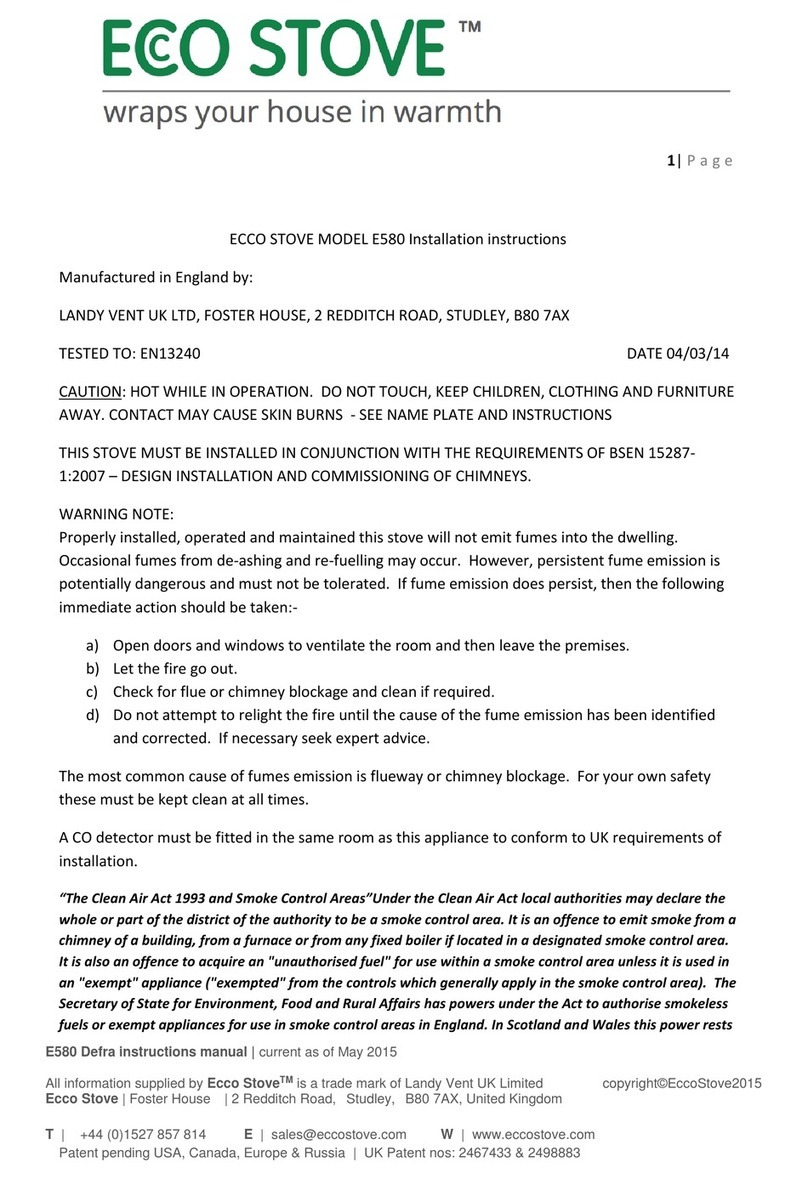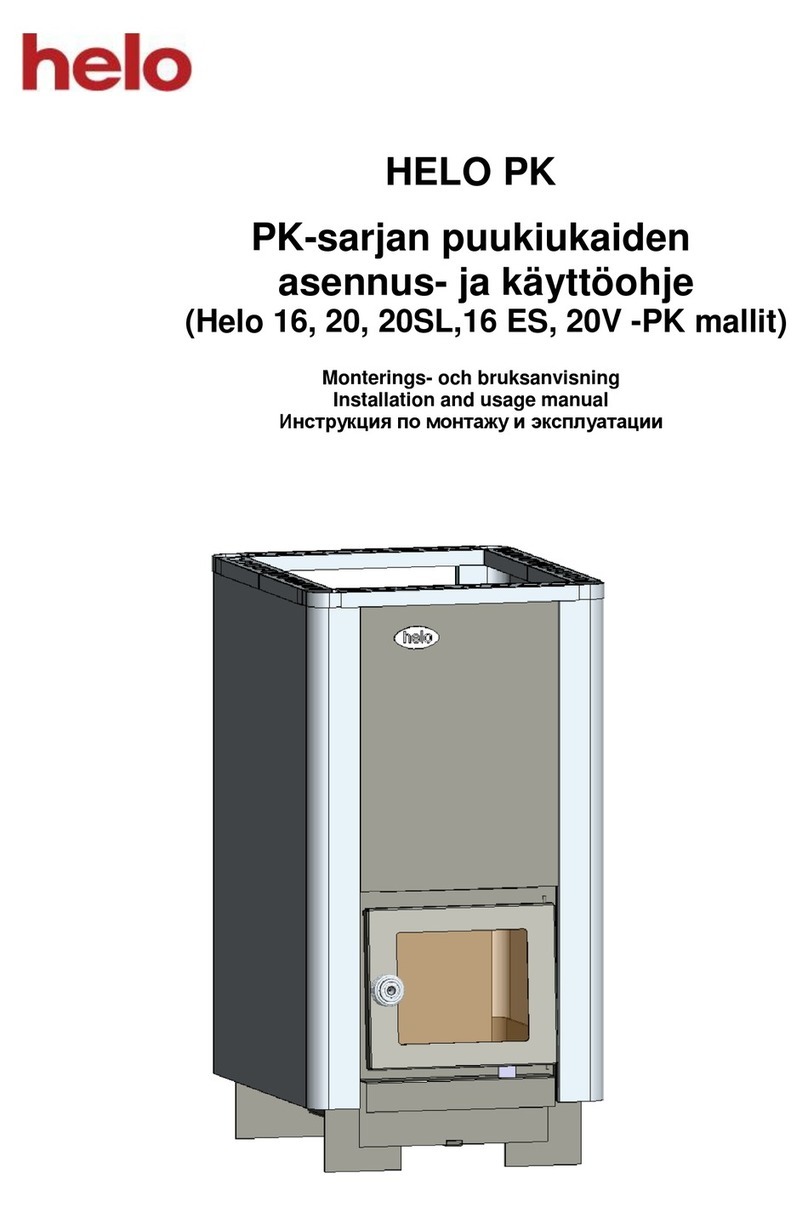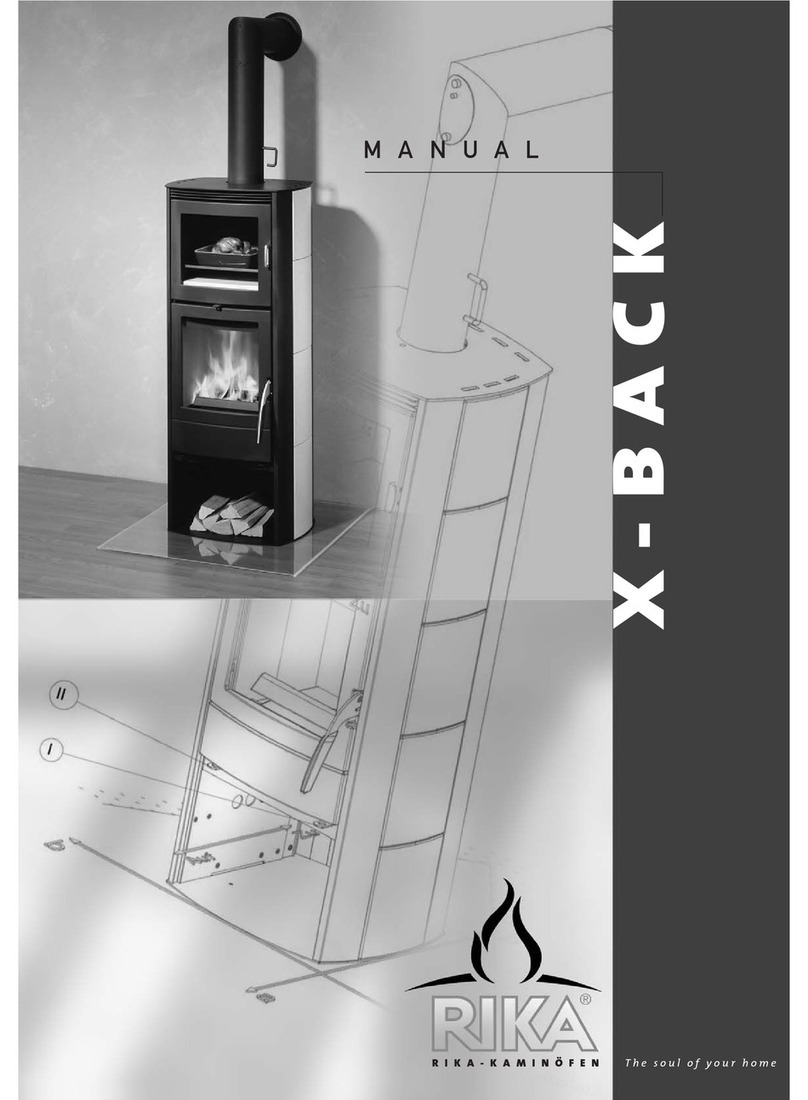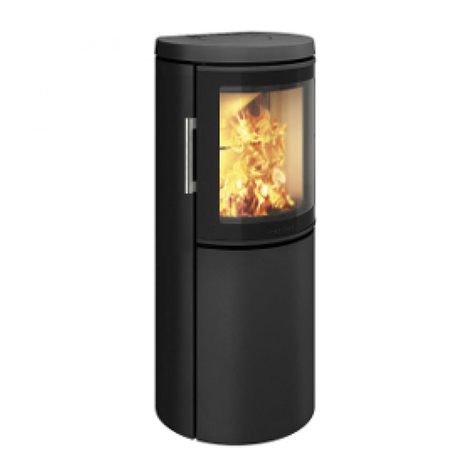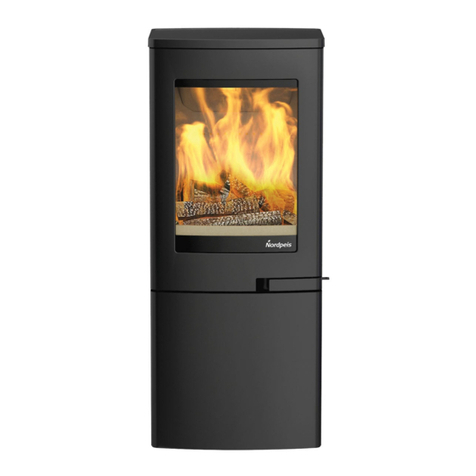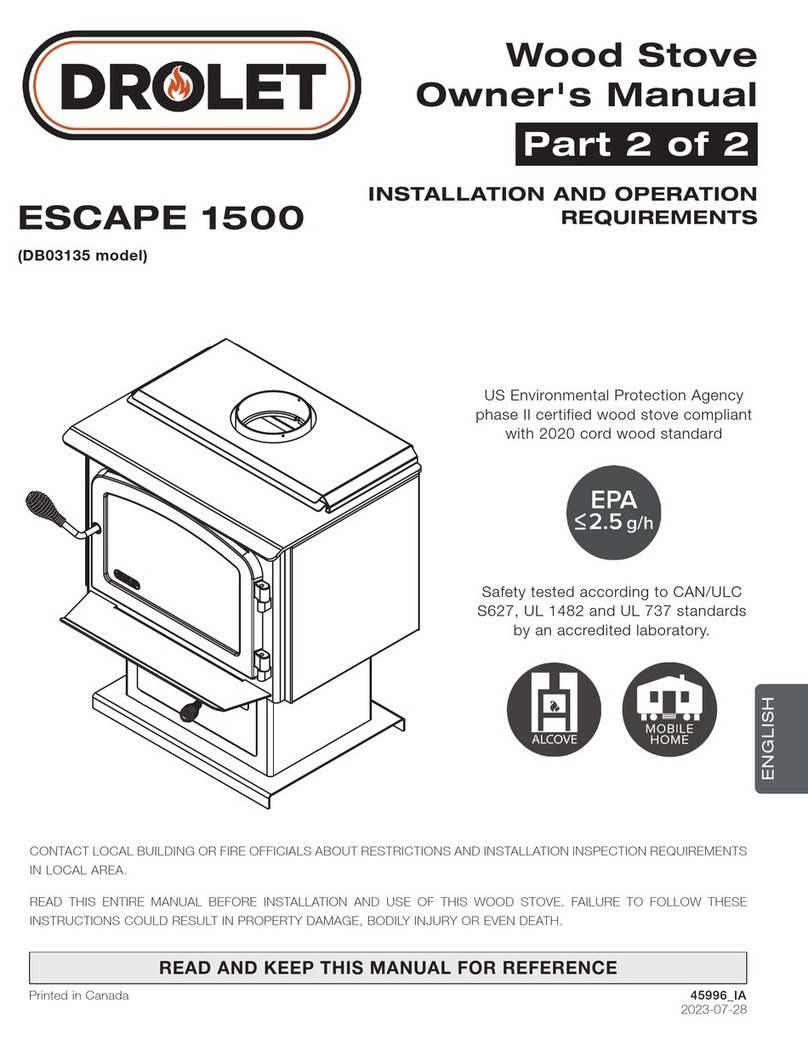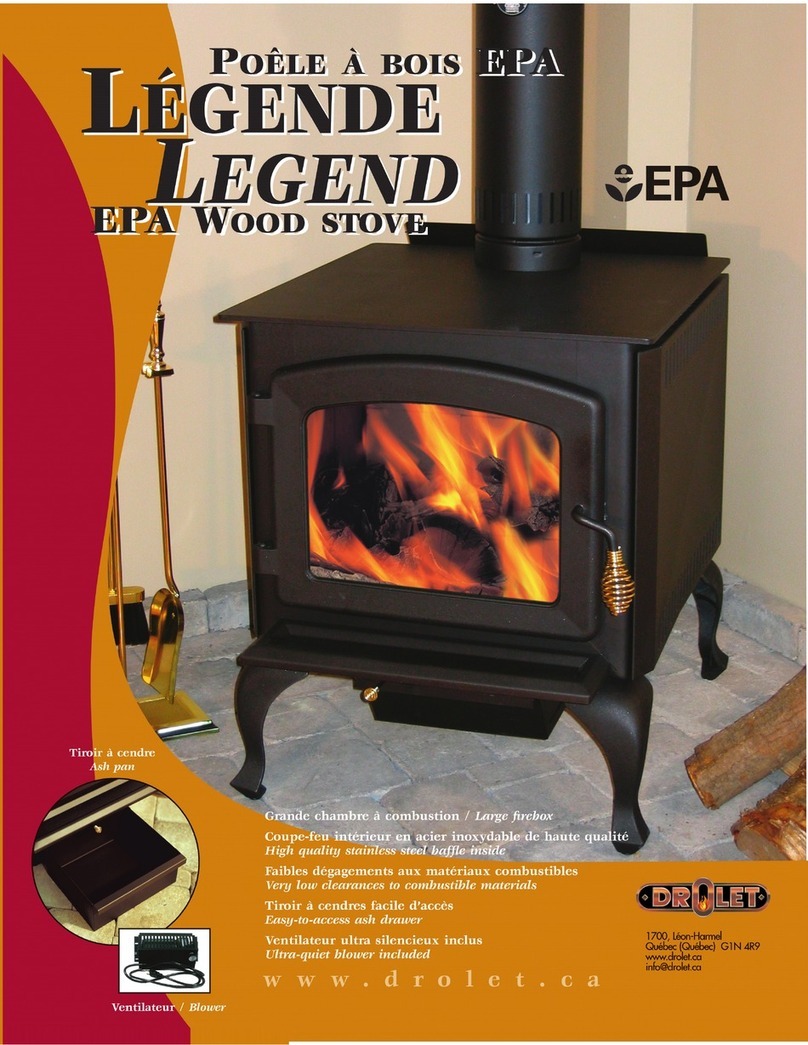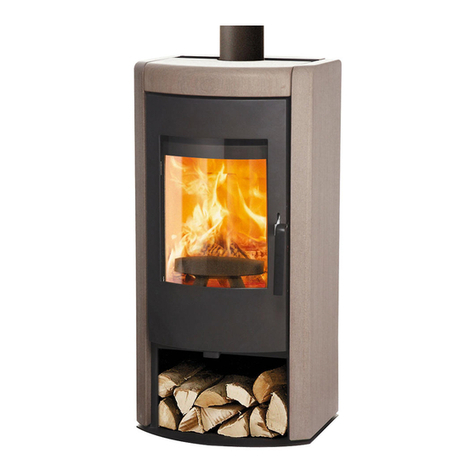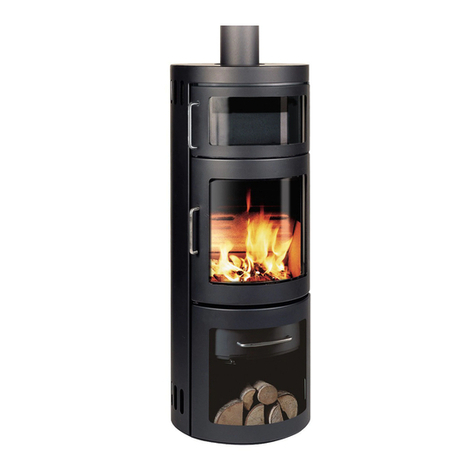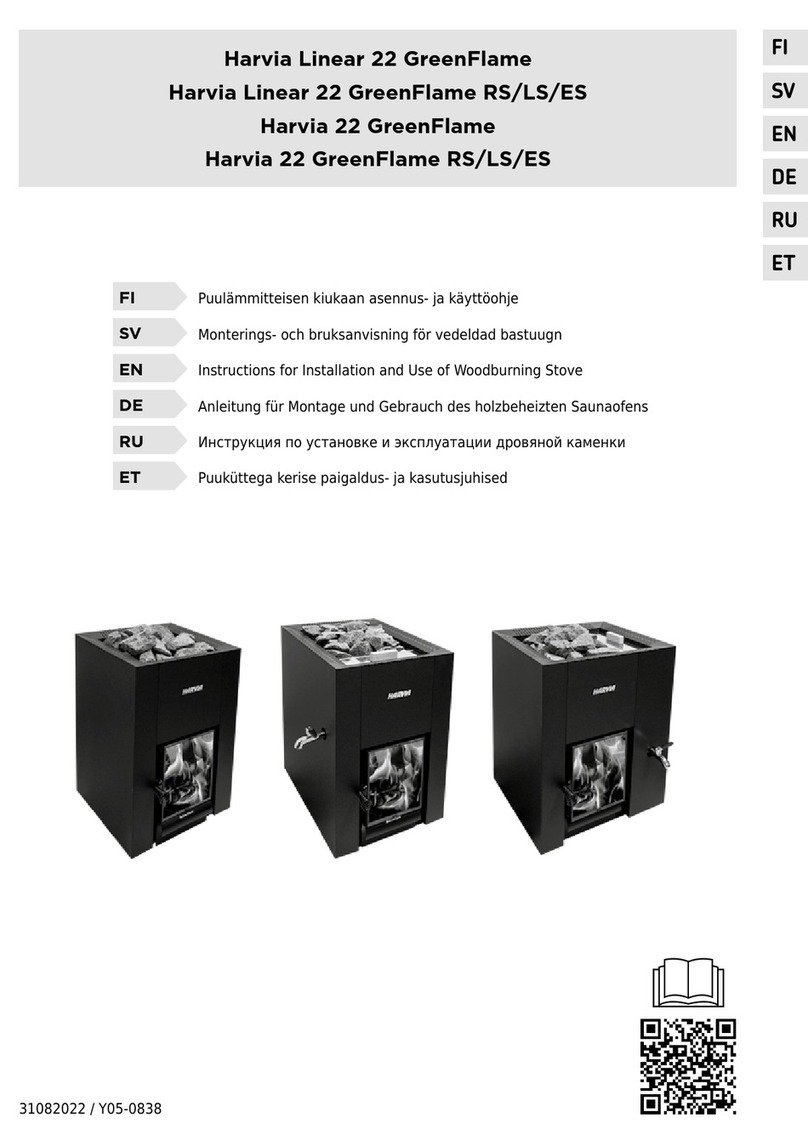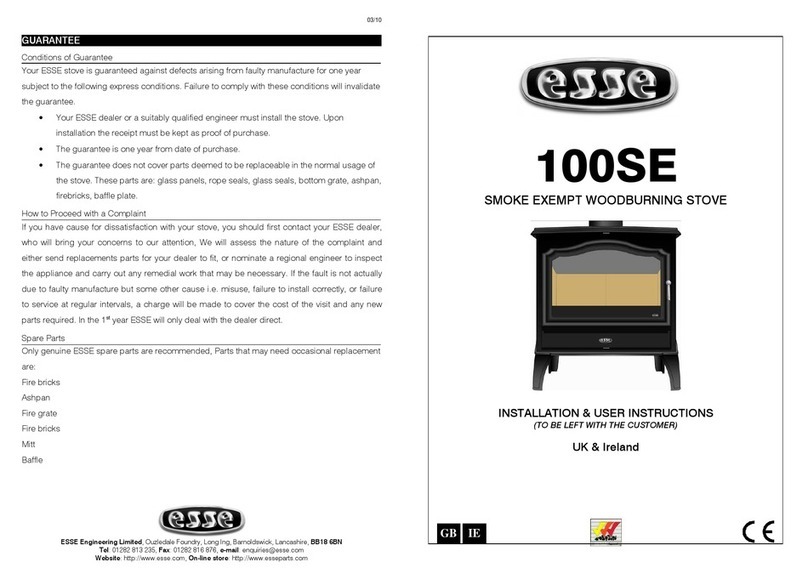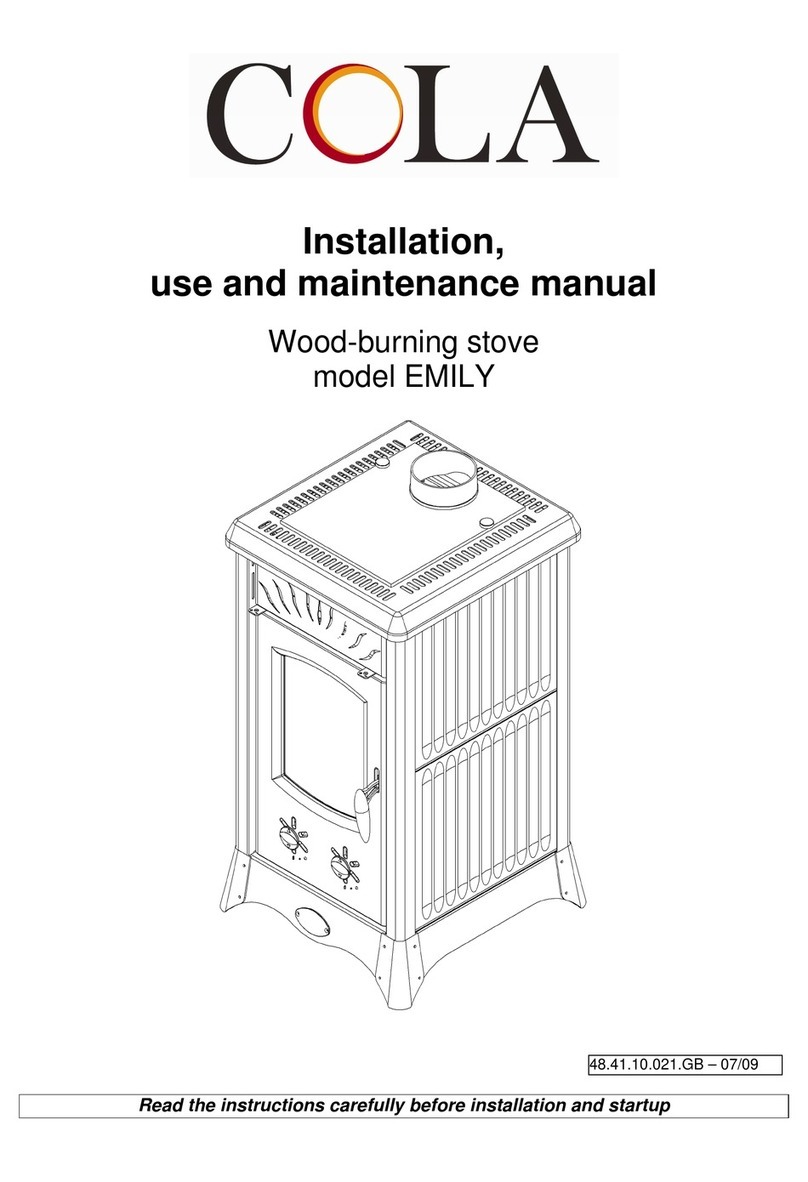ECCO STOVE E678 User manual

1 |P a g e
E850 E678 Instructions | current as of May 2015 | Version 3
All information supplied by Ecco Stove®is a trade mark of Landy Vent UK Limited copyright©EccoStove2015
Ecco Stove | Foster House| 2 Redditch Road,Studley,B80 7AX, United Kingdom
Patent pending USA, Canada, Europe & Russia | UK Patent nos: 2467433 & 2498883
E678 & E850 Instructions Manual
TESTED TO EN15250 AND EN13240
CAUTION: HOT WHILE IN OPERATION. DO NOT TOUCH, KEEP CHILDREN, CLOTHING AND FURNITURE
AWAY. CONTACT MAY CAUSE SKIN BURNS –SEE NAME PLATE AND INSTRUCTIONS.
1. INTRODUCTION
2. PURPOSE
3. MATERIALS
4. FLUE OUTLET
5. GLASS
6. CLEAR GLASS OPERATION
7. AIRATED BACK PLATES
8. ASH GRATE
9. ROPE SEALS
10. FINISHES
11. AIR CONTROLS
a. TERTIARY CONTROL
b. PRIMARY AIR
c. AIR WASH
12. FIRING THE STOVE
a. INITIAL FIRING
b. SUBSEQUENT FIRING
c. RE-FUELLING AFTER STARTING
13. CONTINUOUS RUNNING
14. EXTRA CONTROLS
15. ASH REMOVAL
16. FUELS
a. WOOD
17. RE-FUELLING
18. TAR DEPOSITS
19. FLUE CONNECTION AND FLUE LININGS
20. FLUE CLEANING; CLEANING; MAINTENANCE & OVER SUMMER

2 |P a g e
E850 E678 Instructions | current as of May 2015 | Version 3
All information supplied by Ecco Stove®is a trade mark of Landy Vent UK Limited copyright©EccoStove2015
Ecco Stove | Foster House| 2 Redditch Road,Studley,B80 7AX, United Kingdom
Patent pending USA, Canada, Europe & Russia | UK Patent nos: 2467433 & 2498883
21. PAINT FINISHES
22. ASSEMBLY
22A. HEARTH (LOAD BEARING)
22B. HEARTH (DECCORATIVE)
23. TECHNICAL
A) OUTPUTS
B) WEIGHT
C) AIR SUPPLY
D) EXTRACTOR FANS
E) FLUE DRAUGHT
F) FLUE GAS MASS
G) FLUE GAS TEMPERATURE
H) FLUE OUTLET (DIMENSION AND POSITION)
I) HEAT ENERGY STORED
J) CO CONCENTRATION
24. DUCTED WARM AIR (MODEL 678)
25. GENERAL
A) SAFE OPERATION
DISTANCES (COMBUSTABLE AND NON COMBUSTABLE)
B) MODIFICATIONS
C) PARTS
D) CHIMNEY FIRES
E) SLOW HEAT RELEASE
F) CONTINUOUS BURNING
G) FAULT FINDING
H) WOOD DIMENSIONS
26. TOOLS (REQUIRED)
27. ECCO STOVE WARRANTY

3 |P a g e
E850 E678 Instructions | current as of May 2015 | Version 3
All information supplied by Ecco Stove®is a trade mark of Landy Vent UK Limited copyright©EccoStove2015
Ecco Stove | Foster House| 2 Redditch Road,Studley,B80 7AX, United Kingdom
Patent pending USA, Canada, Europe & Russia | UK Patent nos: 2467433 & 2498883
IMPORTANT FIRST FIRING MUST BE A LOW INEFFICIENT FIRE FOR THE MINIMUM TWO HOURS TO DRY
THE REFACTORY SILICON CARBIDE SLOWLY: FAILURE TO DO SO WILL CRACK THE APPLIANCE.
PLEASE READ THIS ENTIRE MANUAL BEFORE YOU USE YOUR ROOM HEATER. FAILURE TO FOLLOW
INSTRUCTIONS MAY RESULT IN PROPERTY DAMAGE, BODILY INJURY OR EVEN DEATH.
1. INTRODUCTION
We would like to thank you for choosing our product and wish you every success and happiness with
your Ecco Stove®.
Your stove is tested to EN15250 and EN13240 when burning wood logs only.
Please read these instructions. The installation and use of the Ecco Stove is regulated by installation
regulations specific to the country it is to be installed in (building regulations in the UK). The installer
must be aware that all local regulations, including those referring to National and European standards
need to be complied with when installing the appliance.
Not every stove can be connected to every existing chimney. Your installer must check the efficiency
and suitability of the chimney to ensure its suitability for use. If the two are not compatible this can lead
to poor burning and blackening of the glass.
The local authority will be able to inform you of the type of fuel you are allowed to burn in the area the
stove is to be installed. Currently the Ecco stove is tested for wood burning but wood maybe burned in
a smokeless designated zone provided it is operated to the following instructions (see Item 12).
Additionally your installer will be able to advise you on the size of stove required for the space you have.
You will need a sufficient flow of oxygen into the room for combustion, which may require a fresh air
vent to be installed into the room where the appliance will stand.
Some of the technical information you or your installer require is included in this handbook. Our
information leaflet and a technical data table are at the rear of the Ecco Stove catalogue for your
guidance.

4 |P a g e
E850 E678 Instructions | current as of May 2015 | Version 3
All information supplied by Ecco Stove®is a trade mark of Landy Vent UK Limited copyright©EccoStove2015
Ecco Stove | Foster House| 2 Redditch Road,Studley,B80 7AX, United Kingdom
Patent pending USA, Canada, Europe & Russia | UK Patent nos: 2467433 & 2498883
2. PURPOSE
Typical wood burning Stoves are intended as a secondary form of heating. The Ecco Stove is designed to
heat much more of the house as primary and/or secondary heating. Please ensure the Ecco stove is
used within the parameters laid out in this manual.
3. MATERIALS
The Ecco Stove is constructed primarily from a mix of Silicon Carbide, a material that has a high affinity
to absorb heat but radiate it slowly and gently, therefore permeating greater distances within the home
than conventional materials of stove construction.
The Ecco Stove has double pass flue ways prior to exit of flue gasses to exhaust, to enable the maximum
of heat to be extracted and utilised within the appliance and hence the air space within which the
appliance is situated.
Radiant heat is emitted by heat from the external surfaces and initial heat from the front glass door
panel.
4. FLUE OUTLET
Your Ecco Stove is only delivered with a top flue exit due to the construction of the appliance and
contraflow channels. If the installation demands, a 45° elbow can be taken directly from the top of the
stove and back into the chimney Brest and hence the chimney flue. The flue pipe must include a soot
door/ access plate within 200mm of stoves top for stoves flue ways and chimney flue cleaning.
(The flue outlet is 150mm.)
The Ecco Stove must have its own dedicated flue; it cannot be shared with another appliance.
Do not connect this appliance to a chimney serving another unit.
Access must be provided for cleaning the chimney and stove/connector pipe.
5. GLASS
The glass panel provided with your stove is deemed a consumable and may need to be replaced during
the life of the stove. Consumables are not covered by the manufacturers guarantee. In the event of
having to replace the glass in the stove please note that any fixtures should not be more than hand
tight. If captive nuts are used on your stove; please take care not to over tighten them.
Do not over fill the stove as damage or breakage of the glass is normally associated with the door being
closed onto a larger log than the firebox can accommodate.

5 |P a g e
E850 E678 Instructions | current as of May 2015 | Version 3
All information supplied by Ecco Stove®is a trade mark of Landy Vent UK Limited copyright©EccoStove2015
Ecco Stove | Foster House| 2 Redditch Road,Studley,B80 7AX, United Kingdom
Patent pending USA, Canada, Europe & Russia | UK Patent nos: 2467433 & 2498883
6. CLEAR GLASS OPERATION
Blackening of the door glass results from poor quality fuel (unseasoned wood) and initial firing
until the stove has reached its optimum working temperature.
Chimney draft, if less than 0.06 inches water gauge will impair the stove performance and hence
its capability to keep the door glass clean. Your installer will check this for you.
The whole stove body should be a minimum of 150°C to enable the air wash to operate
satisfactorily on the inside of the glass face. (200°C is the optimum operating temperature).
Do not load logs with the end grain pointing toward the glass as this will result in excessive glass
blackening. Always arrange the logs in a wigwam fashion within the firebox. We cannot
guarantee that the stove glass will not blacken but correct usage of fuels and operating
temperatures will usually clean the glass throughout the burn.
7. AIRATED BACK PLATES
The back panels (pre-drilled vermiculite and ceramic coated panels at the rear of the stove) are
consumables and will deteriorate in use. The panels are not covered by the manufacturer’s warranty.
Damage can be caused by excessive firing but more usually by logs being smashed against them when
loading stove. Loading must be carried out with care.
8. ASH GRATE
The grate within your Ecco Stove is made from cast iron being a highly durable material providing ash is
not allowed to sit in the grate bars from the ash tray beneath.
Ash removal is recommended before the grate bars become flooded with ash. The grate is easily
removed by simply lifting it out through the opened glass door.

6 |P a g e
E850 E678 Instructions | current as of May 2015 | Version 3
All information supplied by Ecco Stove®is a trade mark of Landy Vent UK Limited copyright©EccoStove2015
Ecco Stove | Foster House| 2 Redditch Road,Studley,B80 7AX, United Kingdom
Patent pending USA, Canada, Europe & Russia | UK Patent nos: 2467433 & 2498883
9. ROPE SEALS
Regular maintenance of the stove is in part related to rope seals. Seals between the sections are factory
fitted and may remain in place without maintenance unless the appliance is stripped and moved, at
which time all compressive seals between sections must be replaced with like for like diameter rope or
flat tape as fitted to the stove at the time of its construction.
Door/ash pit/cleaning plug and hob cleaning plug seals should be replaced when showing signs of wear
or every two years whichever comes first. Rope seals are not covered by the manufacturer’s warranty.
10. FINISHES
For the first three to five firings your stove will produce what would appear to be toxic fumes and is
often mistaken for smoke leaking out of the appliance. This is just the paint curing onto the appliance.
Please ensure that the room is adequately ventilated and allow the smoke to dissipate in due
course without adding more fuel at that time.
If the paint finish should change colour due to mis-use or over heating you should approach
your Ecco Stove dealer who will provide you with spray aerosol paint in the appropriate colour
to make a paint repair.
The Ecco Stove is produced from a self coloured material and as such variations in colour and texture of
that material may be evident but adding to the uniqueness of the product, unless ordered as a pre-
factory painted or as ready for paint on site finish to co-ordinate with home decor.
11. AIR CONTROLS
Your Ecco Stove has three systems of air inlets for combustion but only one adjustable user control for
ease of use (being the ash pit drawer). All other air inlets are fixed and non adjustable.
11A. TERTIARY AIR
MODEL 850 and 678
The aerated back plates provide tertiary air from a permanently open air inlet at the back of the stove.
This air supply has no facility for being closed and is set permanently open.
Tertiary air is introduced to put the level of the air wash/baffle to re-combust volatiles before they exit
unburnt into the double pass flue ways and chimney flue.

7 |P a g e
E850 E678 Instructions | current as of May 2015 | Version 3
All information supplied by Ecco Stove®is a trade mark of Landy Vent UK Limited copyright©EccoStove2015
Ecco Stove | Foster House| 2 Redditch Road,Studley,B80 7AX, United Kingdom
Patent pending USA, Canada, Europe & Russia | UK Patent nos: 2467433 & 2498883
11B. PRIMARY AIR
The ash pit door is to be used to introduce initial combustion air when
the stove is started from cold or re-fuelled with its body temperature
below 150°C on the top plate.
The ash pit door must be drawn out to the manufactured stop to allow
draft until the top plate has reached 150°C and then closed. (see 11C.)
Ash pit drawer / Primary air control
11C. SECONDARY AIR (AIRWASH)
After the stoves top plate has reached 150°C the ash pit should be closed whereby the preset
(fixed) Secondary air (air wash) control will continue combustion (this must not be adjusted as
pre-set to 4mm).
The air wash control in conjunction with the tertiary control will produce clean combustion and
clear the majority of blackening on the door glass apart from a band at the top or fly ash
deposits on the inner face of the glass (when the stove reaches 175°C or above).
It is important to note that the stoves performance is directly relative to the flue chimneys draft. The
stronger the draft the faster the stove will heat from cold and respond to the air controls.
Excessive draft will cool the stove faster when combustion is finished.

8 |P a g e
E850 E678 Instructions | current as of May 2015 | Version 3
All information supplied by Ecco Stove®is a trade mark of Landy Vent UK Limited copyright©EccoStove2015
Ecco Stove | Foster House| 2 Redditch Road,Studley,B80 7AX, United Kingdom
Patent pending USA, Canada, Europe & Russia | UK Patent nos: 2467433 & 2498883
12. FIRING THE STOVE
Do not over fire the stove for its initial firing within its first twenty four hours run period to ensure
damage does not occur within the castings.
On initial firing and when or if the stove has been unfired for a period in a cold or damp room or
airspace, the bottom cleaning plugs may leak water (condensates).
This will soon clear when the stove flue ways and body begin to warm up.
a) Initial Firing model 850 and 678 (slow heat release for 15250 operation)
The stove may be started with a firelighter or paper twists and kindling.
Start with 1.5kg kindling with the glass door left ajar 5mm or so (no more).
Model 850 –The stove should be fired with 3 loads of 3kg (batches) of wood for total 10kg.
MODEL 678
Once Kindling has begun thorough combustion (about 5 minutes) load with 4 small split logs
approx 150 mm diameter x 320mm long sacked in wigwam fashion (about 2kg).
Pull primary air flow out to manufacturers stop and run until re-loading required and then load
remainder of 10kg wood load (2 batches)
The primary air flow should be reduced to 10mm until stove has reached 150°C design
temperature and then closed. Use in same fashion for 2-3 minutes after each refuelling.

9 |P a g e
E850 E678 Instructions | current as of May 2015 | Version 3
All information supplied by Ecco Stove®is a trade mark of Landy Vent UK Limited copyright©EccoStove2015
Ecco Stove | Foster House| 2 Redditch Road,Studley,B80 7AX, United Kingdom
Patent pending USA, Canada, Europe & Russia | UK Patent nos: 2467433 & 2498883
b) Subsequent Firing Models 850 and 678.
Re-starting the stove after its initial firing should be carried out with
the ash pit cleared out and pulled out for a quarter of its distance up to
the stop/retainer within the ash pit.
A raging lively fire will be seen which is ideal. Run at this rate for the
first load of fuel.
Ash pit drawer / Primary air control
c) Re-fuelling after starting Models 850 and 678
Re-load with 2 further batches of 3kg of dry split logs at each re-fuelling.
Once the fuel has almost burned away re-fuel with a full firebox pulling the primary control out
a quarter (to manufacturers stop) for 2-3 minutes.
Smoke may escape from the top of the doors until the stove has reached 150°C and when re-
fueling.
Run for a few minutes if the stove has reached 150°C to ensure combustion of the new fuel has
begun.
d) Over Firing warning Models 850 and 678
Do not over fill the fire box, 3 kg or so of split logs is a typical full load. Running the stove above 200°C
constitutes over firing the stove and after which point damage may occur to the stove.
Under firing warning
Do not run the stove under 150°C on “tick over” as this can result in tar or creosote build-up in the flue
and within the stove.

10 |P a g e
E850 E678 Instructions | current as of May 2015 | Version 3
All information supplied by Ecco Stove®is a trade mark of Landy Vent UK Limited copyright©EccoStove2015
Ecco Stove | Foster House| 2 Redditch Road,Studley,B80 7AX, United Kingdom
Patent pending USA, Canada, Europe & Russia | UK Patent nos: 2467433 & 2498883
13. CONTINUOUS BURNING (Standard stove operation for 13240 designation) Models 850 and 678
a) Initial Firing
The stove may be started with a firelighter or paper twists and kindling.
The stove should be loaded with 4 split logs about 150mm diameter x 320mm long stocked in
wigwam fashion in the fire box.
The primary air control should be pulled out to the manufacturers set stop. Run until re-loading
is needed, where upon add the remainder of the first 10 kg batch of wood (2-3 batches).
Do not over fire the stove for its initial firing within its first twenty four hours run period to
ensure damage does not occur within the castings.
The stove may be run night and day continuously but will not continue to burn longer than 1.5 -
2.5 hours before re-fuelling (dependent upon how well the flue draws and density or condition
of the fuel that is being burned).
b) Subsequent Firing
Re-starting the stove after its initial firing should be carried out with the ash pit cleared out and
pulled out for a quarter of its distance up to the stop/retainer within the ash pit. A raging lively
fire will be seen which is ideal. Run at this rate for the first load of fuel.
c) Re-fuelling after starting
Refuelling must only be carried out with sufficient fuel within the stove to immediately ignite
the new fuel load. Overloading could cause excessive smoke.
If the fire bed is too low for immediate ignition of the new fuel load suitable kindling must be
used to restart the fire.
Re-fuel before the initial load of fuel is fully burned away with maximum 150mm diameter split
dry logs stacked with the end grain pointing away from the door.
Run for a short period with the ash pit door pulled out to the manufacturers stop to establish a
bright fire then close. The stove may be run on this basis for as long as needed.
Your Ecco stove will not stay in overnight. It will need re-lighting the next morning.

11 |P a g e
E850 E678 Instructions | current as of May 2015 | Version 3
All information supplied by Ecco Stove®is a trade mark of Landy Vent UK Limited copyright©EccoStove2015
Ecco Stove | Foster House| 2 Redditch Road,Studley,B80 7AX, United Kingdom
Patent pending USA, Canada, Europe & Russia | UK Patent nos: 2467433 & 2498883
14. EXTRA CONTROLS Models 850 and 678
Excessive draft over .006 inches of water gauge may be moderated by installing a draft diverter into the
flue pipe off the top of the stove and duly balanced. Speak to your retailer for advice or fitting.
15. ASH REMOVAL Models 850 and 678
Ash removal must only be carried out when the stove is not alight as by removing the ash draw
would over fire the appliance.
To remove ash collected in the ash draw, simply pull out the ash draw to its quarter extended
position; pull up safety catch leaver on the side of the ash draw upon which the ash draw may
be fully extracted for cleaning.
Always re-fit the ash draw after emptying fully following the lighting/firing procedure at 21c in
this instruction manual
16. FUELS
16a Wood
Wood as a fuel must be maximum 20% moisture content and split logs are nominally 400mm
maximum in length and 10 - 15 cms in diameter or below for best combustion, (measured at any
one point over the width of the split log) see 25h) for explanation.
Harder, more dense logs or wood will generally burn more slowly. Timber should ideally be
loaded in wigwam fashion or flat across the width of the stoves fire box to ensure the end grain
does not release volatiles towards the glass door and hence blacken it quickly.
Under no circumstances must the Ecco Stove be used as an incinerator to burn household or
industrial waste of any description –only untreated 20% humidity wood must be used.
Liquid fuels must not be burned on this appliance.
17. RE-FUELLING (for smoke control areas) Models 850 and 678
When the Ecco Stove has been on a minimum or 2-3 hours burning, re-fuelling should either be
carried out with two or three split logs at each time, to ensure proper and complete
combustion, and produce minimum smoke. (Fuel loaded to be maximum 150mm diameter x
320mm maximum length).

12 |P a g e
E850 E678 Instructions | current as of May 2015 | Version 3
All information supplied by Ecco Stove®is a trade mark of Landy Vent UK Limited copyright©EccoStove2015
Ecco Stove | Foster House| 2 Redditch Road,Studley,B80 7AX, United Kingdom
Patent pending USA, Canada, Europe & Russia | UK Patent nos: 2467433 & 2498883
Ideally re-fuel on a bright fire. If the fire has burned down to sparse embers the stove may be
re-fuelled with two or three logs or a full fire box upon which the ash pit draw should be drawn
out quarter way (to the safety stop) and the stove fired for 5 –10 minutes to create initial
combustion, then closed to allow clean air controls (tertiary and air wash) to take over. (Follow
initial lighting procedures).
Smoke may escape the door if re-fuelling is carried out on a bright or lively fire if the stove body
is below 150°C. Open the door to the fire box slowly when re-fuelling to minimise smoke
spillage into the room as the door will create a vacuum drawing the smoke out of the fire box
unless the flue ways are above 150°C. UNDER NO CIRCUMSTNCES MUST THE STOVE BE
OPERATED WITH THE DOOR OPEN APART FOR REFUELLING OTHERWISE EXCESSIVE SMOKE WILL
BE PRODUCED.
18. TAR DEPOSITS
Tar deposits will not form in the stove or on its flue ways if adequately seasoned logs (below 25%
moisture content are used) and the stove generally burned above 150°C with a bright fire.
If tar deposits form in either the fire box or the flue way, the fuel being burned is not adequately
seasoned and damage will occur within the stove along with poor performance.
19. FLUE CONNECTION AND FLUE LININGS Models 850 and 678
The flue outlet on the stoves top is 150mm+ and accepts a 150mm stove pipe which must be
bedded into the outlet with fire cement for a gas tight seal. (Minimum 1mm thick metal pipe)
The nominal flue outlet of the Ecco Stove is 150mm diameter for which a 150mm flue liner
insulated around within the masonry chimney with perlite grains or similar or rockwool wrap is
strongly advised, or a suitably insulated pre-fabricated twin wall stainless steel flue system.
Any joints must be self tap screwed and jointed with fire cement.
Flue’s up to 9m in height are adequate in 150mm inner diameter.
Flues over 9m in height should be 175mm in the diameter.
High temperature hot face inner linings or coatings are suitable materials but ideally with a
maximum flue area of 225 x 225mm.
Pumice hot face linings with insulation or leka pellets are suitable.

13 |P a g e
E850 E678 Instructions | current as of May 2015 | Version 3
All information supplied by Ecco Stove®is a trade mark of Landy Vent UK Limited copyright©EccoStove2015
Ecco Stove | Foster House| 2 Redditch Road,Studley,B80 7AX, United Kingdom
Patent pending USA, Canada, Europe & Russia | UK Patent nos: 2467433 & 2498883
Under no circumstances should the Ecco Stove be connected directly to clay linings within chimneys,
unless those clay liners have a hot face lining fitted within, in order to reduce condensation within the
chimney flue.
20. CLEANING AND MAINTENANCE Models 850 and 678
Flue ways within the Ecco Stove should be cleaned two monthly in continuous combustion for
which the stove should be let out (not burning).
Cleaning access points are located on the stoves top surface (4 hot plates) which must be lifted
vertically to access the vertical flue ways (2 each side).
After brushing down (and up) the deposits can be scraped or vacuumed out by removing the
cleaning plugs located on the front of the bottom section (2 discs).
The first section of flue pipe vertically off the appliances top flue outlet MUST include a flue
cleaning access.
Clean down through this into the stoves top; brush along the top flue chamber beneath the flue
outlet and vacuum out that chamber by sliding a flexible vac hose to left and right.
Seasonal Use.
During a period when the stove will not be fired for example, during the summer period, leave the ash
pit door open, 2mm, to minimise condensation build up within the stove. Clean the flue ways as
described in the previous paragraphs (20. Cleaning and Maintenance) and clean out both the ashtray
and fire box. You may oil the outer paint surface with a light mist of releasing oil, similar to WD40 and
leave for the next heating season.
Check the rear back baffle boards and replace if cracked or broken.
Check all seals are fixed firmly in place on the door; ash pit front and cleaning plugs.
Remove and or clean above the steel gull wing baffle plate in the top of the firebox.
Ensure the chimney flue and stove pipe are swept early summer time or after stoves shut down
for the summer.
Oil the door hinges and door catch mechanism all in readiness for the new heating season.
a) Adverse flue conditions (downdraught or pressurisation) will result in poor performance; door
glass blackening and sooting in the flue ways. Such conditions must be rectified by improving
flue performance immediately. Clean any tar/deposits off the door glass.
b) Repairs or replacements must be carried out by a competent engineer.
Flueways are accessed by removing the cleaning plugs at a+ b + c + d and brushing vertically with the
flue brush provided.

14 |P a g e
E850 E678 Instructions | current as of May 2015 | Version 3
All information supplied by Ecco Stove®is a trade mark of Landy Vent UK Limited copyright©EccoStove2015
Ecco Stove | Foster House| 2 Redditch Road,Studley,B80 7AX, United Kingdom
Patent pending USA, Canada, Europe & Russia | UK Patent nos: 2467433 & 2498883
After cleaning vertically and horizontally the cleaning plugs at the front of base should be
removed and cleaned out with a vacuum cleaner or suction hose.
Lastly remove the gull wing baffle at top of fire chamber and shake off –slide the whole
assembly toward the rear of the stove and then left or right to drop down. Re-instate in reverse
order.
Always check the flue is clear after a prolonged period of shutdown or non use.
Plugs must always be re-fitted firmly in place before lighting or whilst running the Ecco Stove.
The firebox door and ash pit door should remain closed at all times other than re-fuelling (See
lighting and refuelling instructions)
The Grate should be de-ashed by raking through the fire box door to ensure combustion air can
flow through the grate bars (only carry out these works when the stove is not alight).
The door glass may be cleaned of either grey transparent fly ash deposits or tar deposits from its
inner surface with a proprietary glass cleaner available from your retailer.
The stove is now ready for re-use after all cleaning plugs have been re-fitted.
21. PAINT FINISHES
Paint finishes on your Ecco Stove may produce a heavy chemical smell for a number of initial firings from
being newly painted.
You may colour co-ordinate your Ecco Stove by painting its outer surfaces with non oil based or non-
flammable paints. (Certain paints may discolour however).
22. ASSEMBLY
Model 850
The Ecco Stove is delivered in 9 main structural parts being bottom section* grate section; left sides;
right sides; back section; lower front top section; lower back top section and upper top section* .
Model 678
The Ecco Stove is delivered in 7 main structural parts: bottom section, grate section, left and right sides,
back section, baffle brick and top section.
Secondary points are two rear baffles (Vermiculite); vermiculite spacer blocks; one fixed front grate
plug. Two slide in vermiculite flueway dividers for left and right sides (Model 850 only); one cast iron
grate;

15 |P a g e
E850 E678 Instructions | current as of May 2015 | Version 3
All information supplied by Ecco Stove®is a trade mark of Landy Vent UK Limited copyright©EccoStove2015
Ecco Stove | Foster House| 2 Redditch Road,Studley,B80 7AX, United Kingdom
Patent pending USA, Canada, Europe & Russia | UK Patent nos: 2467433 & 2498883
Eleven further non-structural parts are included being door section and frame; ash can; two lower
bottom section cleaning plugs; 4 top section cleaning plugs and 1 front lower top section airwash control
with spinner.
Six inner components are separate being back vermiculite tertiary airwash boards (two) and upper steel
top baffle.
One flue cleaning brush, one operating tool and one thermometer are included.
22a) HEARTH (LOAD BEARING)
The Ecco Stove Model 850 must stand on a load bearing hearth capable of carrying 800kg with an overall
width of 850mm and depth of 575mm (allowing 50mm gap behind the stove) or to suit in-country
requirements if different from the above.
The Ecco Stove Model 678 must stand on a load bearing hearth capable of carrying 550kg with an overall
width of 678mm and depth of 525mm (allowing 50mm gap behind the stove) or to suit in-country
requirements if different from the above.
22b) HEARTH (DECCORATIVE)
Must extend 150mm either side or 225mm in front of the Ecco Stove as a minimum or to suit in country
requirements if different from the above.
APPLIANCE ASSEMBLY
Items shown with an * should be lifted in with a proprietary lifting
frame.
All other items should be lifted by two or more people.
PARTS
A* LOWER BOTTOM PART
To be placed on level structural hearth, this section must be laid level
and minimum 50mm from rear wall or 600mm (Model 850)
550mm (Model 678) if combustible. (The circular hole at the rear of the
appliance must remain plugged with the vermiculite plug fitted).
Model 850

16 |P a g e
E850 E678 Instructions | current as of May 2015 | Version 3
All information supplied by Ecco Stove®is a trade mark of Landy Vent UK Limited copyright©EccoStove2015
Ecco Stove | Foster House| 2 Redditch Road,Studley,B80 7AX, United Kingdom
Patent pending USA, Canada, Europe & Russia | UK Patent nos: 2467433 & 2498883
PHOTOGRAPH 1 Position the ‘T’ shaped joint seal / trim onto the top
horizontal face ready for the next layer to hold in place.
B GRATE SECTION
This inner section is lowered into Part A and the cast iron grate fitted
within. (No seals are fitted to this part). Ensure it is located on its domed
carbide locating pips by shuffling to bed into place.
Ba. Fit the cast iron grate into the recess within the Silicon Carbide
grate section.
C LEFT SIDE
This section to be stood firmly onto Part A using the locating pips to
position accurately. Ensure this section neatly holds the joint seal/trim
into place. Shuffle it to bed into its carbide locating pips.
Model 850
Model 678
Model 850
Base and grate section
Aa POSITION TRIM
Ab Slide the ash can assembly into the opening in the lower
bottom part.
Ac Fit the two smaller cleaning plugs into the holes on the
front of the lower bottom part.

17 |P a g e
E850 E678 Instructions | current as of May 2015 | Version 3
All information supplied by Ecco Stove®is a trade mark of Landy Vent UK Limited copyright©EccoStove2015
Ecco Stove | Foster House| 2 Redditch Road,Studley,B80 7AX, United Kingdom
Patent pending USA, Canada, Europe & Russia | UK Patent nos: 2467433 & 2498883
E BACK SECTION
The back section has a tapered base which fits into the taper on the
bottom section. Stand the back section carefully in place gently
wedging off the rear wall of the stoves chosen location until held
in position by the rear top section:
F VERMICULITE DIVIDERS (into right and left hand vertical flueways) –Model 850 only.
Slide each vermiculite divider into the rebate in both left and right hand
sides. Ensure they are cut off flush with the tops of the left and right hand
sides. The rope seal must be to the top.
Including back baffles showing spacer piece to stand the bottom of the
baffles off the rear of the stove.
Fa. Position the vermiculite spacer block, 2 blocks for 678 Model, flat
against the back section such that the pre-drilled vermiculite back baffles
are spaced off the back section to allow an air flow behind them but are
held at their front by the two lugs on the cast iron grate.
Model 850
Model 850
D RIGHT SIDE
This section to be stood firmly onto Part A using the locating pips
to position accurately. Ensure this section neatly holds the joint
seal/trim into place. Shuffle it to bed onto its carbide locating pips.
NOTE: The tertiary air intake hole should be at the bottom and not
the top of the back section. This hole is to be left permanently
open. Ensure the rear section locates down inside the rear trim and
doesn’t ride high on the trims flange.
Model 678

18 |P a g e
E850 E678 Instructions | current as of May 2015 | Version 3
All information supplied by Ecco Stove®is a trade mark of Landy Vent UK Limited copyright©EccoStove2015
Ecco Stove | Foster House| 2 Redditch Road,Studley,B80 7AX, United Kingdom
Patent pending USA, Canada, Europe & Russia | UK Patent nos: 2467433 & 2498883
G. DOOR SECTION
Door section should now be lowered over the sides until it sits firmly and
squarely onto the bottom section. Seals must be fitted (10mm round
rope) into the groove down left and right hand sides and across the grate
section to enable the door frame to seal onto.
Model 678
H. POSITION TRIM
The ‘T’ shaped joint seal/trim onto the top horizontal face ready
for the next section to hold in place. This seal butts up to the door
frame left and right. (Middle trim for Model 850 top trim for
Model 678)
Ha. Model 850 Position the steel baffle assembly with the shaped
curve pointing down and as close to the glass of the door as
possible. No fixings should be used to ensure it can be replaced
without dismantling the stove.
Model 678 steel baffle has air tubes linking it to the vermiculite
pre-drilled back boards to introduce hot air to mix with the air
wash/secondary burn process. The rear section of the steel baffle
must sit into the stoves back panel and house the vermiculite
back boards in front of its half box section.
odel 678
Model 850

19 |P a g e
E850 E678 Instructions | current as of May 2015 | Version 3
All information supplied by Ecco Stove®is a trade mark of Landy Vent UK Limited copyright©EccoStove2015
Ecco Stove | Foster House| 2 Redditch Road,Studley,B80 7AX, United Kingdom
Patent pending USA, Canada, Europe & Russia | UK Patent nos: 2467433 & 2498883
I.* LOWER REAR TOP SECTION Model 850 only
The lower top part can now be lifted into place when its compressive weight
will hold the other sections beneath it firmly in place. Ensure this section
neatly holds the joint seal / trim into place.
J. LOWER FRONT TOP SECTION Model 850 only
This section when fitted over its locating pips may need to be held in place
with the strap around it and the lower top section behind until the upper
top section has been lowered into place and therefore holding all sections
beneath it in place with its compressive weight.
There is no vertical seal between the low top part and front top sector.
Ja POSITION TRIM Model 850 only
K* UPPER TOP SECTION
This section should be lowered into place and will locate the sections beneath
it with the locating pips.
Add all cleaning plugs and air controls into place. NOTE, only the correct plugs
will fit the correct opening. The front two plugs are deeper than the back two.
Fitting them the wrong way round will impair the stoves performance.
Ka. Fit the four cast iron or alloy cleaning plugs into place.
Important: Wherever seals are fitted the installer must ensure
they are fixed firmly in place before locating each part with its
previous part without the use of cements or mastics
Model 678
Model 850
Model 850

20 |P a g e
E850 E678 Instructions | current as of May 2015 | Version 3
All information supplied by Ecco Stove®is a trade mark of Landy Vent UK Limited copyright©EccoStove2015
Ecco Stove | Foster House| 2 Redditch Road,Studley,B80 7AX, United Kingdom
Patent pending USA, Canada, Europe & Russia | UK Patent nos: 2467433 & 2498883
L. FLUEING.
The stove may be connected with a 150mm stove pipe to the flue it will
operate on SEE SECTION 19 (FLUE CONNECTIONS). The connecting stove pipe
pushes into the flue outlet. Fire cement or rope may be used.
M.
It will be necessary to beat the trims into shape for an improved fit to reduce
gaps as each piece moulds differently with each appliance.
CAUTION ONLY A RUBBER MALLETT MUST BE USED.
THE STOVE MAY NOW BE LIT
23.
MODEL 850
TECHNICAL HEATING APPLIANCE BS13240 SLOW HEAT RELEASE APPLIANCE BS15250
a) Outputs: nominated output 11.5kw Thermal output 134 MJ
Nett efficiency 79.1% Efficiency 85.3%
Gross efficiency 73% CO .24%
Space heating 7500 cu ft / 212 cu metres
b) Weight: Complete appliance = 800 kg; The Ecco Stove must be installed onto a structural hearth
capable of bearing this weight.
c) Air Supply –UK 35.75 cm sq.: outside UK to those countries local requirements. Vents to be
fitted to outside and positioned such that they are not liable to block. Additional ventilation
requirement may be needed if the stove is operated simultaneously with other heating
appliances. It is important to ensure adequate supply of combustion and ventilation air.
d) Extractor fans: No extractor fans are to be fitted in the same room as the Ecco Stove.
e) Fire draught: Minimum cold flue draught to be .04 inches water gauge, maximum .06 inches
water gauge.
f) Flue gas mass flow: 11.4 gs
g) Flue gas temperature: Average 222°C at nominal output.
h) Flue outlet: 150mm top exit (Dampers may be necessary if the flue draught is in excess of 0.4”
water gauge). This pipe must include a soot door/access plate within 200 mm of the stoves top.
i) Heat energy stored 134 MJ
j) Co-concentration at 13% oxygen = 0.34%. Excessive flue draught may remove too much heat
from the Ecco Stove on slow combustion. A damper may be fitted into the flue pipe off the
This manual suits for next models
1
Table of contents
Other ECCO STOVE Wood Stove manuals
Popular Wood Stove manuals by other brands
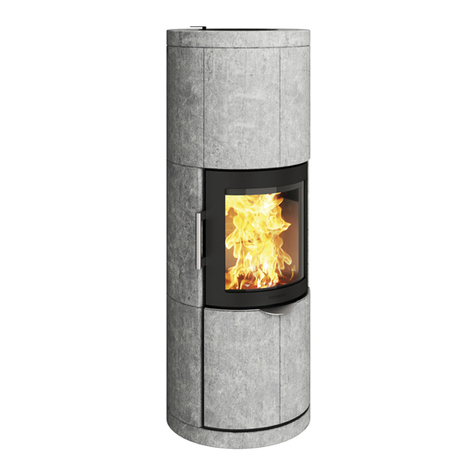
HWAM
HWAM 7150 user manual
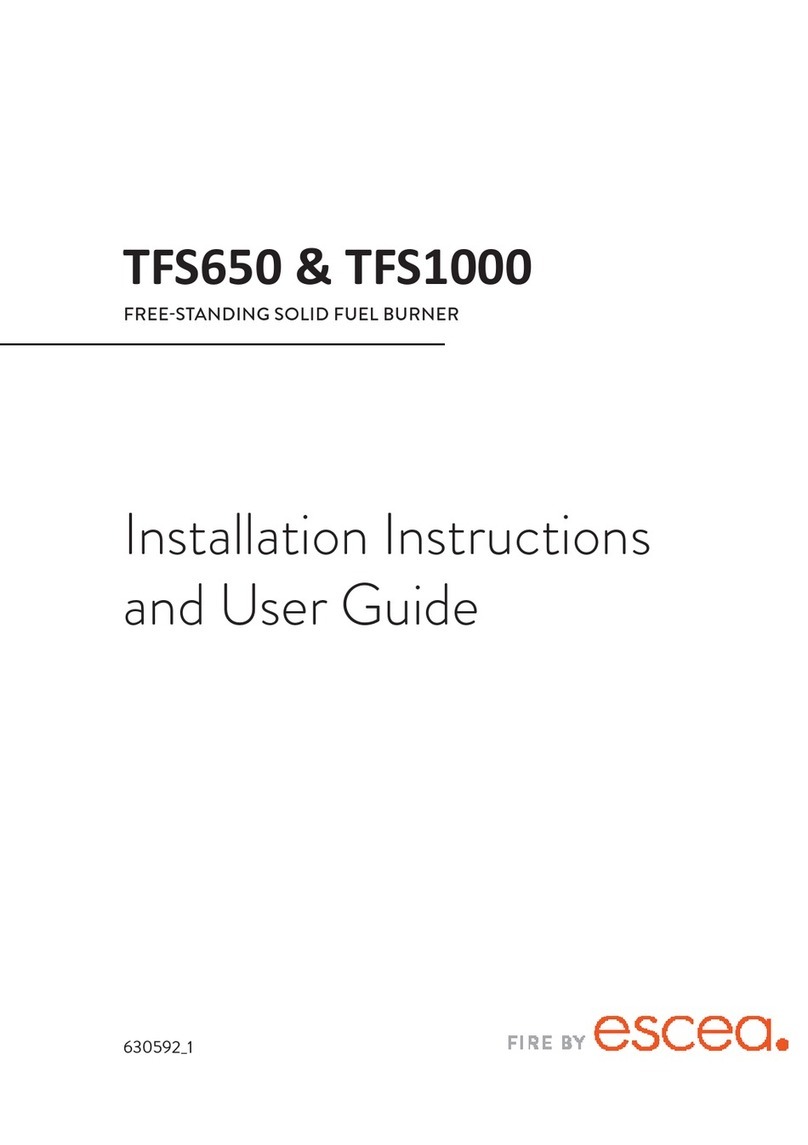
Escea
Escea TFS Series Installation instructions and user guide

Ventis
Ventis HEI170 Installation and operation manual
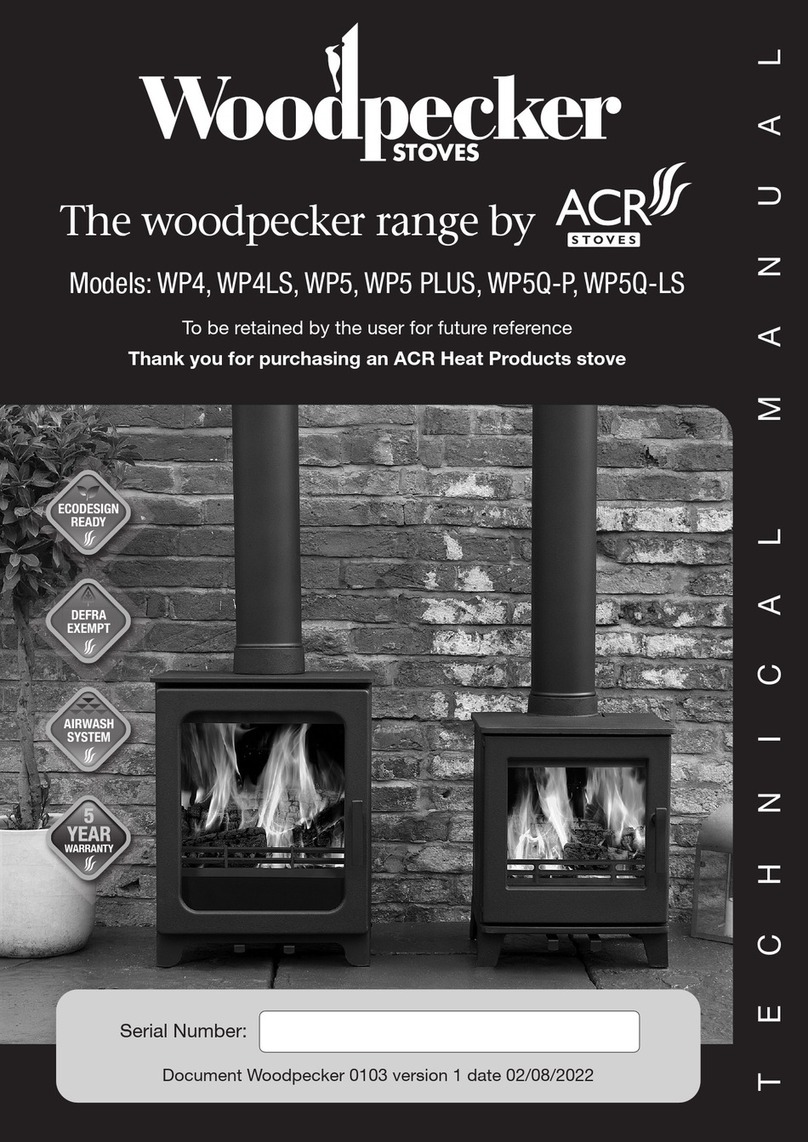
ACR STOVES
ACR STOVES Woodpecker WP5 PLUS Technical manual

Contura
Contura C 790K installation instructions
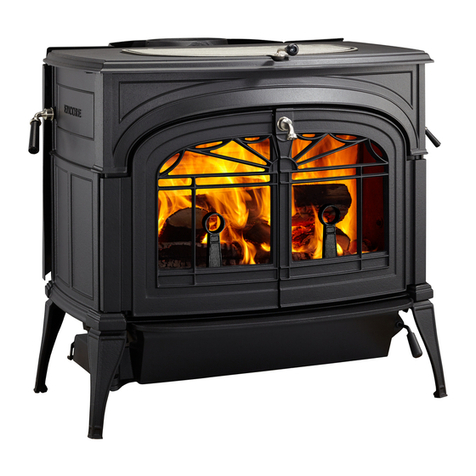
Vermont Castings
Vermont Castings Encore 1450 Homeowner's installation and operating manual

